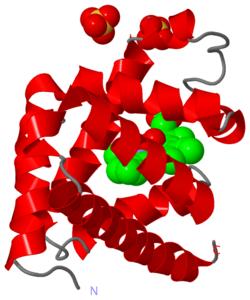JMS/sandbox15
From Proteopedia
(Difference between revisions)
| Line 12: | Line 12: | ||
'''Molecular Tour. The''' ability of increasing net charge to enable higher solubility is a known phenomenon<ref>doi: 10.1073/pnas.0402797101</ref>, and this study is consistent with previous reports<ref>PMID: 14741208</ref>. The aquatic animals have increased their net charge in a variety of ways - different combinations of amino acids switches. We present one such manifestation of this overall trend, by comparing the elephant and whale myoglobin structures. | '''Molecular Tour. The''' ability of increasing net charge to enable higher solubility is a known phenomenon<ref>doi: 10.1073/pnas.0402797101</ref>, and this study is consistent with previous reports<ref>PMID: 14741208</ref>. The aquatic animals have increased their net charge in a variety of ways - different combinations of amino acids switches. We present one such manifestation of this overall trend, by comparing the elephant and whale myoglobin structures. | ||
| - | Out of 27 divergent amino acids between whale and elephant's myoglobin - from a total of 153 amino acids - only 8 of these amino acids lead to changes of charge. These eight amino acids are shown for whales and elephants, <scene name='57/575026/Electrostatics/19'>side by side</scene>. The whale amino acids, have an illustrative eletrostatic field drawn around the <scene name='57/575026/Electrostatics/17'>electrically charged atom</scene> in the residue. Next to the whale amino acid, the <scene name='57/575026/Electrostatics/18'>elephant residues</scene> are shown in yellow halos and labelled with the residue name. From studying the differences between these two proteins, it is clear that the whale protein has more areas with a positive electrostatic field. These positive electrostatic fields are <scene name='57/575026/Electrostatics/19'>scattered about the surface</scene> of the whale protein, and will repel any whale myoglobin, preventing the protein-protein interactions that lead to aggregation. Another way to say this, in the case of proteins <scene name='57/575026/Electrostatics/16'>in solvents such as water</scene>, is that <scene name='57/575026/Electrostatics/21'>water binds to the hydrogens</scene> coming off a positively charged atom, or associates with the charged atom itself, thus screening | + | Out of 27 divergent amino acids between whale and elephant's myoglobin - from a total of 153 amino acids - only 8 of these amino acids lead to changes of charge. These eight amino acids are shown for whales and elephants, <scene name='57/575026/Electrostatics/19'>side by side</scene>. The whale amino acids, have an illustrative eletrostatic field drawn around the <scene name='57/575026/Electrostatics/17'>electrically charged atom</scene> in the residue. Next to the whale amino acid, the <scene name='57/575026/Electrostatics/18'>elephant residues</scene> are shown in yellow halos and labelled with the residue name. From studying the differences between these two proteins, it is clear that the whale protein has more areas with a positive electrostatic field. These positive electrostatic fields are <scene name='57/575026/Electrostatics/19'>scattered about the surface</scene> of the whale protein, and will repel any whale myoglobin, preventing the protein-protein interactions that lead to aggregation. Another way to say this, in the case of proteins <scene name='57/575026/Electrostatics/16'>in solvents such as water</scene>, is that, for each and every protein, <scene name='57/575026/Electrostatics/21'>water binds to the hydrogens</scene> coming off a positively charged atom, or associates with the charged atom itself, thus screening each protein from the other proteins. Note also that the effective size of the electric field of the charged atom at the end of residues like lysine is actually larger, because of the multiple conformations a long residue <scene name='57/575026/Electrostatics/17'>like lysine</scene> moves between. |
This picture, while illustrative of the basic principles of how small electrostatic fields changes can greatly increase a protein's solubility, is incomplete. In fact, among other considerations, one needs to consider neighboring residues to these divergent residues, in order to calculate the actual electrostatic field. It may be in some cases, that a negatively charged residues neigbors one of these additional positive residues, and from a distance relatively larger than the distance between the two oppositely charged residues, the electrostatic field is zero. | This picture, while illustrative of the basic principles of how small electrostatic fields changes can greatly increase a protein's solubility, is incomplete. In fact, among other considerations, one needs to consider neighboring residues to these divergent residues, in order to calculate the actual electrostatic field. It may be in some cases, that a negatively charged residues neigbors one of these additional positive residues, and from a distance relatively larger than the distance between the two oppositely charged residues, the electrostatic field is zero. | ||
Revision as of 17:27, 8 April 2014
| |||||||||||
References:
- ↑ 1.0 1.1 Mirceta S, Signore AV, Burns JM, Cossins AR, Campbell KL, Berenbrink M. Evolution of mammalian diving capacity traced by myoglobin net surface charge. Science. 2013 Jun 14;340(6138):1234192. doi: 10.1126/science.1234192. PMID:23766330 doi:http://dx.doi.org/10.1126/science.1234192
- ↑ Brocchieri L. Environmental signatures in proteome properties. Proc Natl Acad Sci U S A. 2004 Jun 1;101(22):8257-8. Epub 2004 May 24. PMID:15159533 doi:http://dx.doi.org/10.1073/pnas.0402797101
- ↑ Goh CS, Lan N, Douglas SM, Wu B, Echols N, Smith A, Milburn D, Montelione GT, Zhao H, Gerstein M. Mining the structural genomics pipeline: identification of protein properties that affect high-throughput experimental analysis. J Mol Biol. 2004 Feb 6;336(1):115-30. PMID:14741208 doi:http://dx.doi.org/10.1016/S0022283603014748

